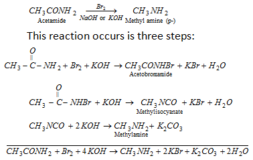Salt hydrolysis

source : SlideServe
Salt hydrolysis-
Hydrolysis of salt of weak acid and weak base-
In such salts , both the cation of weak base and anion of weak acid will undergo hydrolysis simultaneously .
Ex – CH3COONH4 (ammonium acetate), NH4F( ammonium fluoride)
NH4+ + CH3COO– + H2O ———> NH4OH + CH3COOH
According to law of mass action,
Hydrolysis constant ‘Kh‘ = [NH4OH][CH3COOH] / [NH4+][CH3COO–] [H2O]
Water is present in excess hence can be regarded as constant.
Kh = [NH4OH][CH3COOH] / [NH4+][CH3COO–] ————eq 1
CH3COOH ⇌ CH3COO– + H+
Ka = [CH3COO–][H+] / [CH3COOH] ———– eq 2
NH4OH ⇌ NH4+ + OH–
Kb = [NH4+][OH–] / [NH4OH ] ———— eq 3
H2O ⇌ H+ + OH–
Kw = [H+][OH–] ———– eq 4
By eq (2) ,(3) and (4)
Kw / Ka.Kb = [NH4OH][CH3COOH] [H+][OH–] / [NH4+][OH–] [CH3COO–] [H+]
Kw / Ka.Kb = [NH4OH][CH3COOH] / [NH4+][CH3COO–] ——– eq 5
comparing eq (1) and (5)
Kw / Ka.Kb = Kh
Degree of hydrolysis and hydrolysis constant-
NH4 + + CH3COO– + H2O ⇌ NH4OH + CH3COOH
weak ion weak ion
Before hydrolysis C C 0 0
After hydrolysis C ( 1-h) C ( 1-h) Ch Ch
Kh = [NH4OH][CH3COOH] / [NH4+][CH3COO–]
Water is present in excess hence can be regarded as constant.
Kh = Ch x Ch / C (1-h).C (1-h)
Kh = h2/(1-h)2
because (1-h) is nearly equal to one therefore ,
Kh = h2
h = √ Kh
h = degree of hydrolysis
because ,
Kh = Kw / Ka.Kb
h = √ (Kw / Ka.Kb)
” The degree of hydrolysis of salt of weak acid and weak base does not depend upon the concentration of salt”
Expression for the pH of the salt solution –
CH3COOH ⇌ CH3COO– + H+
Ka = [CH3COO–][H+] / [CH3COOH]
[H+] = Ka [CH3COOH] / [CH3COO–]
[H+] = Ka. Ch/ C(1-h)
[H+] = Ka. h / (1-h)
because (1-h) is nearly equal to one therefore ,
[H+] = Ka. h
because ,
h = √ (Kw / Ka.Kb)
[H+] = Ka√ (Kw / Ka.Kb)
[H+] = √ (Kw . Ka / Kb)
Taking log and reverting the sign through out,
-log [H+] = – 1/2 log Kw -1/2 log Ka + 1/2 log Kb
-log [H+] = pH , – log Kw = pKw , – log Ka = pKa , – log Kb = pKb
pH = 1/2 pKw + 1/2 log pKa – 1/2 log pKb
pH = 7 + 1/2 log pKa – 1/2 log pKb
” The pH of salt of weak acid and weak base is independent of concentration of salt.
When pKa > pKb , than solution will be alkaline and pH value will be more than 7. In case pKb > pKa , than e solution will be acidic and pH value will be less than 7.







